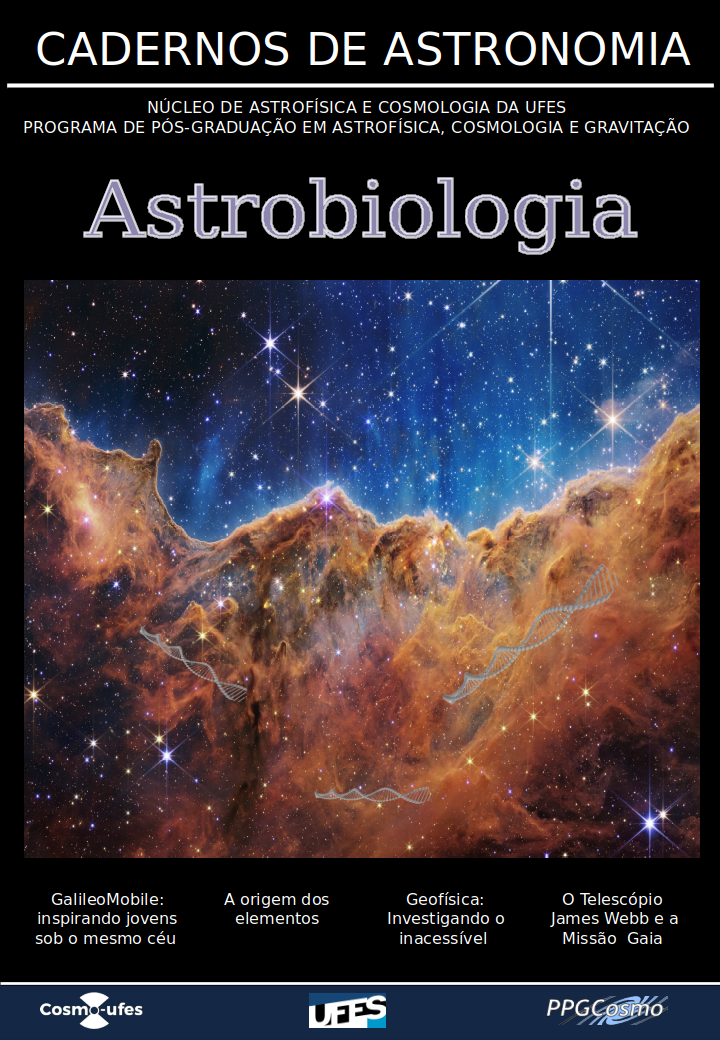Missão Espacial Gaia
DOI:
https://doi.org/10.47456/Cad.Astro.v3n2.38511Palavras-chave:
Missão Espacial Gaia, telescópios espaciais, Via Láctea, galáxias, astrometriaResumo
Com observações cuidadosas e sistemáticas do céu, há muito tempo o ser humano vem construindo e refinando o seu conhecimento a respeito do Universo e de si mesmo. As grandezas observacionais sobre as quais repousa a astronomia estão sendo, finalmente, abundantemente medidas e com precisões inimagináveis graças à Missão Espacial Gaia da Agência Espacial Europeia. Com seus três data releases (2016, 2018 e 2020/22), temos, hoje, em nossas mãos, dados observacionais em quantidade e com qualidade com as quais até bem pouco tempo nem sonhávamos. Entre eles, a grandeza mais importante de toda a astronomia: a distância de mais de um 1,5 bilhão de estrelas que nos permite dizer onde se encontram, como são e como ''dançam'', iniciando assim, uma nova era no estudo da Galáxia e do Universo. Esses dados, disponibilizados para o mundo todo ao mesmo tempo, representam uma alteração radical na base do conhecimento astronômico e impactam tremendamente a astronomia no sentido mais amplo do termo, por muitos e muitos anos. Colegas de todas as partes do mundo estão mergulhados nesse oceano de posições, movimentos, brilhos, cores, etc, confirmando, revendo e refinando o que sabemos e prestes a enfrentarem, uma vez mais na história, o novo.
Referências
Gaia Collaboration et al., The Gaia mission, Astronomy & Astrophysics 595, A1 (2016). ArXiv:1609.04153.
Gaia Collaboration et al., Gaia data release 1 - summary of the astrometric, photometric, and survey properties, A&A 595, A2 (2016).
A. G. Brown, Microarcsecond astrometry: Science highlights from Gaia, Annual Review of Astronomy and Astrophysics 59(1), 59 (2021).
Gaia Collaboration et al., Gaia Data Release 2. Summary of the contents and survey properties, Astronomy & Astrophysics 616, A1 (2018). ArXiv:1804.09365.
Gaia Collaboration et al., Gaia Data Release 2. The celestial reference frame (Gaia-CRF2), Astronomy & Astrophysics 616, A14 (2018). ArXiv:1804.09377.
Gaia Collaboration et al., Gaia Early Data Release 3. Summary of the contents and survey properties, Astronomy & Astrophysics 649, A1 (2021). ArXiv:2012.01533.
Gaia Collaboration et al., Gaia Data Release 3: The extragalactic content (2022). ArXiv: 2206.05681.
Gaia Collaboration et al., Gaia Data Release 3: A golden sample of astrophysical parameters (2022). ArXiv:2206.05870.
Gaia Collaboration et al., Gaia Data Release 3: Reflectance spectra of Solar System small bodies (2022). ArXiv:2206.12174.
C. Ducourant et al., Gaia Data Release 3: Surface brightness profiles of galaxies and host galaxies of quasars (2022). ArXiv: 2206.14491.
P. Tanga et al., Data Release 3: the Solar System survey (2022). ArXiv:2206.05561.
The HIPPARCOS and TYCHO catalogues. Astrometric and photometric star catalogues derived from the ESA HIPPARCOS Space Astrometry Mission, vol. 1200 de ESA Special Publication (ESA Publications Division, 1997).
B. Viateau et al., The Bordeaux and Valinhos CCD meridian circles, Astron. Astrophys. Suppl. Ser. 134, 173 (1999).
L. Lindegren et al., Gaia Data Release 1. Astrometry: One billion positions, two million proper motions and parallaxes, Astronomy & Astrophysics 595, A4 (2016). ArXiv: 1609.04303.
E. Høg et al., The Tycho-2 catalogue of the 2.5 million brightest stars, Astronomy & Astrophysics 355, L27 (2000).
D. Michalik, L. Lindegren e D. Hobbs, The Tycho-Gaia astrometric solution . How to get 2.5 million parallaxes with less than one year of Gaia data, Astronomy & Astrophysics 574, A115 (2015). ArXiv:1412.8770.
A. Krone-Martins, Ampliando horizontes da Missão Espacial Gaia graças à análise de objetos extensos, Tese de Doutorado, Universidade de São Paulo e Universitè de Bordeaux I, São Paulo (2011).
A. Krone-Martins et al., Pushing the limits of the Gaia space mission by analyzing galaxy morphology, Astronomy & Astrophysics 556, A102 (2013). ArXiv:1307.5732.
A. Krone-Martinsa et al., Identification of galaxies from the Gaia DR2 – ALLWISE all-sky catalogues with unsupervised machine-learning, submetido ao Astronomy & Astrophysics (2022).
R. E. de Souza et al., Detection of galaxies with Gaia, Astronomy & Astrophysics 568, A124 (2014). ArXiv:1404.4521.
Downloads
Publicado
Edição
Seção
Licença
Copyright (c) 2022 Ramachrisna Teixeira

Este trabalho está licenciado sob uma licença Creative Commons Attribution 4.0 International License.






